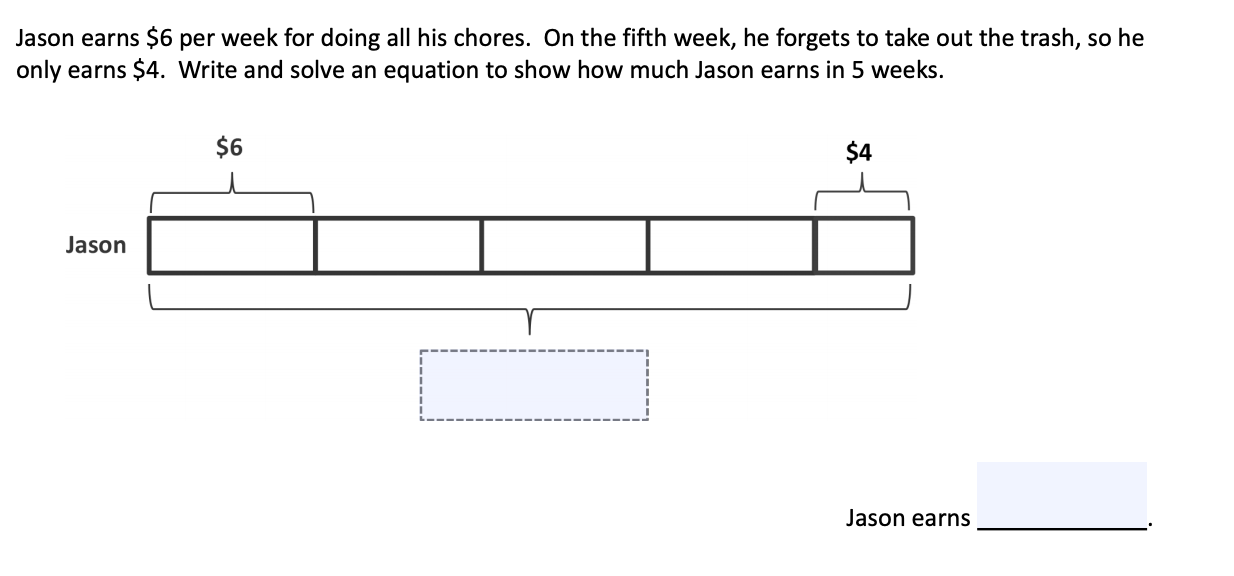Draw an array showing 5 rows of 4.
Then write a multiplication equation.
What is the product?
5 x 4 = 20
The product is 20.
4 x 5 =
20
21 ÷ 7 =
The quotient is 3.
Write the commutative property of 4 x 3.
What is the product of 4 x 3?
4 x 3 = 3 x 4
The product is 12.
Seven students share 28 silly bands equally.
How many bands does each student receive?
Each student receives 4 silly bands.
Draw an array for 7 rows of 3.
Write a multiplication equation.
What is the product?
7 x 3 = 21
The product is 21.
6 x 2 =
12
20 ÷ 5 =
The quotient is 4.
Write the commutative property of 9 x 2.
What is the product?
9 x 2=2 x 9
The product is 18.

6 x 4 = 24
1 x 4 = 4
24 + 4 = 28
He earns $28 dollars.
Draw arrays for 8 x 3 and 3 x 8.
Write a two multiplication equations to match each array.
How are the two arrays alike/different?
8 x 3 = 24
3 x 8 = 24
The number of rows and number in each group changed, but the product remained the same.
5 x 8 =
40
27 ÷ 3 =
The quotient is 9.
Write the commutative property of 2 x 7.
2 x 7 = 7 x 2
The product is 14.
Ms. Egeregor buys 27 books for her classroom library. She buys an equal number of fiction, nonfiction, and poetry books. She shelves all of the poetry books first. How many books Ms. Egeregor has left to shelve?
27 ÷ 3 = 9
27 - 9 = 18
She has 18 books left to shelve.
Draw two arrays to represent 9 x 3 and 3 x 9.
What is the product?
The product is 27
7 x 4 =
28
35 ÷5 =
The quotient is 7.
Using shaded and unshaded circles, show the distributive property for 3 rows of 4 and 2 rows of 4.
Write the equations for the shaded and unshaded equations.
(3 x 4) + (2 x 4) =
12 +8 =
20
Eudora buys 21 meters of ribbon. She cuts the ribbon so that each piece measures 3 meters in length.
a. How many pieces of ribbon does she have?
b. If Eudora needs a total of 12 pieces of the shorter ribbon, how many more pieces of the shorter ribbon does she need?
21 ÷ 3 = 7
7 meters is shorter than 21 meters, so
12 x 7 =
(10 x 7) + (2 x 7)=
70 + 14 = 84
Draw two arrays to show 6 x 3 and 3 x 6.
What is the product?
The product is 18.
8 x 6 =
48
60 ÷ 10 =
The quotient is 6.
Use the distributive property to show 5 x 3 and 2 x 3.
Use shaded and unshaded circles to draw your response.
Write the multiplication equation and solve.
(5 x 3) + (2 x 3)=
15 + 6 =
21
Orlando buys a box of 18 fruit snacks. Each box comes with an equal number of strawberry-, cherry-, and grape-flavored snacks. He eats all of the grape-flavored snacks. Draw and label a tape diagram to find how many fruit snacks he has left.
18 ÷ 3 = 6
18 -6 = 12
He has 12 fruit snacks left.